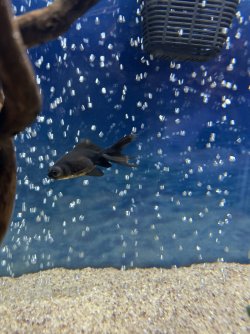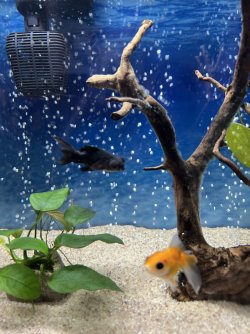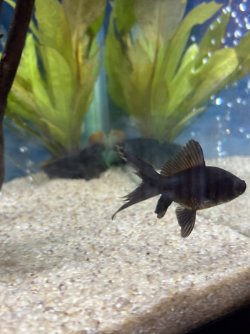Hey everyone, I made the mistake of putting a male betta finish into my 40 gallon goldfish tank. Before anyone comments about it, just know that I’m aware what I did was idiotic, lol. Anyways long story short after being in the tank for about 48 hours the male betta really ripped up my goldfishs tails, especially on my black moor. The betta fish has now been separated into situated into his own 10 gallon aquarium. But my question to you all is, any advice in terms of helping my fish heal from the damage that’s been done to their tails? Anything that can be recommended is greatly appreciated!
You are using an out of date browser. It may not display this or other websites correctly.
You should upgrade or use an alternative browser.
You should upgrade or use an alternative browser.
Betta Fish Attacked Goldfish
- Thread starter ericmat
- Start date
The April FOTM Contest Poll is open!

🏆 Click to vote! 🏆
Lots of clean water and maybe some salt.
Good to know! The tank has been set up for roughy 8-9 monthsSkip the salt for now...fresh clean water is best for healing
How long has the tank been set up?
Basic First Aid For Fish
Wipe the inside of the glass down with a clean fish sponge. This removes the biofilm on the glass and the biofilm will contain lots of harmful bacteria, fungus, protozoans and various other microscopic life forms.
Do a 75% water change and gravel clean the substrate every day for a week. The water changes and gravel cleaning will reduce the number of disease organisms in the water and provide a cleaner environment for the fish to recover in. It also removes a lot of the gunk and this means any medication can work on treating the fish instead of being wasted killing the pathogens in the gunk.
Make sure any new water is free of chlorine/ chloramine before it is added to the tank.
Clean the filter if it hasn't been done in the last 2 weeks. However, if the filter is less than 6 weeks old, do not clean it. Wash the filter materials/ media in a bucket of tank water and re-use them. Tip the bucket of dirty water on the garden/ lawn. Cleaning the filter means less gunk and cleaner water with fewer pathogens.
Increase surface turbulence/ aeration to maximise the dissolved oxygen in the water.
Maybe add some salt, (see directions below).
------------------
SALT
You can add rock salt (often sold as aquarium salt), sea salt, or swimming pool salt to the aquarium at the dose rate of 1 heaped tablespoon per 20 litres of water. If there is no improvement after 48 hours you can double that dose rate so there is 2 heaped tablespoons of salt per 20 litres.
Keep the salt level like this for at least 2 weeks but no longer than 4 weeks otherwise kidney damage can occur. Kidney damage is more likely to occur in fish from soft water (tetras, Corydoras, angelfish, Bettas & gouramis, loaches) that are exposed to high levels of salt for an extended period of time, and is not an issue with livebearers, rainbowfish or other salt tolerant species.
The salt will not affect the beneficial filter bacteria, fish, plants, shrimp or snails.
After you use salt and the fish have recovered, you do a 10% water change each day for a week using only fresh water that has been dechlorinated. Then do a 20% water change each day for a week. Then you can do bigger water changes after that. This dilutes the salt out of the tank slowly so it doesn't harm the fish.
If you do water changes while using salt, you need to treat the new water with salt before adding it to the tank. This will keep the salt level stable in the tank and minimise stress on the fish.
When you first add salt, add the salt to a small bucket of tank water and dissolve the salt. Then slowly pour the salt water into the tank near the filter outlet. Add the salt over a couple of minutes.
Wipe the inside of the glass down with a clean fish sponge. This removes the biofilm on the glass and the biofilm will contain lots of harmful bacteria, fungus, protozoans and various other microscopic life forms.
Do a 75% water change and gravel clean the substrate every day for a week. The water changes and gravel cleaning will reduce the number of disease organisms in the water and provide a cleaner environment for the fish to recover in. It also removes a lot of the gunk and this means any medication can work on treating the fish instead of being wasted killing the pathogens in the gunk.
Make sure any new water is free of chlorine/ chloramine before it is added to the tank.
Clean the filter if it hasn't been done in the last 2 weeks. However, if the filter is less than 6 weeks old, do not clean it. Wash the filter materials/ media in a bucket of tank water and re-use them. Tip the bucket of dirty water on the garden/ lawn. Cleaning the filter means less gunk and cleaner water with fewer pathogens.
Increase surface turbulence/ aeration to maximise the dissolved oxygen in the water.
Maybe add some salt, (see directions below).
------------------
SALT
You can add rock salt (often sold as aquarium salt), sea salt, or swimming pool salt to the aquarium at the dose rate of 1 heaped tablespoon per 20 litres of water. If there is no improvement after 48 hours you can double that dose rate so there is 2 heaped tablespoons of salt per 20 litres.
Keep the salt level like this for at least 2 weeks but no longer than 4 weeks otherwise kidney damage can occur. Kidney damage is more likely to occur in fish from soft water (tetras, Corydoras, angelfish, Bettas & gouramis, loaches) that are exposed to high levels of salt for an extended period of time, and is not an issue with livebearers, rainbowfish or other salt tolerant species.
The salt will not affect the beneficial filter bacteria, fish, plants, shrimp or snails.
After you use salt and the fish have recovered, you do a 10% water change each day for a week using only fresh water that has been dechlorinated. Then do a 20% water change each day for a week. Then you can do bigger water changes after that. This dilutes the salt out of the tank slowly so it doesn't harm the fish.
If you do water changes while using salt, you need to treat the new water with salt before adding it to the tank. This will keep the salt level stable in the tank and minimise stress on the fish.
When you first add salt, add the salt to a small bucket of tank water and dissolve the salt. Then slowly pour the salt water into the tank near the filter outlet. Add the salt over a couple of minutes.
That's a mean betta attacking a goldfish!
That's a mean betta attacking a goldfish!
He wasn't being mean, he was just being a betta. They're not called fighting fish for nothing!
D
Deleted member 149562
Guest
Unfortunately unlike their human owners, a Betta is not able to differentiate tween fish species or types thereof that share their territory.
The Betta (or Siamese Fighting Fish) saw those lovely flowy tials and fins..."Hang on a minute....what is that other flashy so'n'so doing in MY territory?!?!"
And so like a Bloodhound chasing a squirrel, the Goldfish has been well and truly chewed. Needless to say that the Betta will have given it plenty of warnings before finally (and quite literally) letting rip. Warnings that were sadly missed by the human and ignored by the dumb Goldfish.
Please do not place a Betta into any aquarium with other fish....they may start all cute and cuddly but inside every Betta there is a temper worse than a Great White Shark when it comes to who owns the entire aquarium.
The Betta (or Siamese Fighting Fish) saw those lovely flowy tials and fins..."Hang on a minute....what is that other flashy so'n'so doing in MY territory?!?!"
And so like a Bloodhound chasing a squirrel, the Goldfish has been well and truly chewed. Needless to say that the Betta will have given it plenty of warnings before finally (and quite literally) letting rip. Warnings that were sadly missed by the human and ignored by the dumb Goldfish.
Please do not place a Betta into any aquarium with other fish....they may start all cute and cuddly but inside every Betta there is a temper worse than a Great White Shark when it comes to who owns the entire aquarium.
honestly, he was probably stressed. Just my two centsHe wasn't being mean, he was just being a betta. They're not called fighting fish for nothing!
CaptainBarnicles
Moderate Pleco Tolerator
Staff member
Global Moderator ⚒️
Tank of the Month 🏆
Pet of the Month 🎖️

Duhhonestly, he was probably stressed. Just my two cents
With the notable exception of other male bettas, the betta is the biggest woosie fish in the world. They can basically be destroyed by any other fish.He wasn't being mean, he was just being a betta. They're not called fighting fish for nothing!
Debatably, yes. But I personally disagree. good pointWith the notable exception of other male bettas, the betta is the biggest woosie fish in the world. They can basically be destroyed by any other fish.
Basic First Aid For Fish
Wipe the inside of the glass down with a clean fish sponge. This removes the biofilm on the glass and the biofilm will contain lots of harmful bacteria, fungus, protozoans and various other microscopic life forms.
Do a 75% water change and gravel clean the substrate every day for a week. The water changes and gravel cleaning will reduce the number of disease organisms in the water and provide a cleaner environment for the fish to recover in. It also removes a lot of the gunk and this means any medication can work on treating the fish instead of being wasted killing the pathogens in the gunk.
Make sure any new water is free of chlorine/ chloramine before it is added to the tank.
Clean the filter if it hasn't been done in the last 2 weeks. However, if the filter is less than 6 weeks old, do not clean it. Wash the filter materials/ media in a bucket of tank water and re-use them. Tip the bucket of dirty water on the garden/ lawn. Cleaning the filter means less gunk and cleaner water with fewer pathogens.
Increase surface turbulence/ aeration to maximise the dissolved oxygen in the water.
Maybe add some salt, (see directions below).
------------------
SALT
You can add rock salt (often sold as aquarium salt), sea salt, or swimming pool salt to the aquarium at the dose rate of 1 heaped tablespoon per 20 litres of water. If there is no improvement after 48 hours you can double that dose rate so there is 2 heaped tablespoons of salt per 20 litres.
Keep the salt level like this for at least 2 weeks but no longer than 4 weeks otherwise kidney damage can occur. Kidney damage is more likely to occur in fish from soft water (tetras, Corydoras, angelfish, Bettas & gouramis, loaches) that are exposed to high levels of salt for an extended period of time, and is not an issue with livebearers, rainbowfish or other salt tolerant species.
The salt will not affect the beneficial filter bacteria, fish, plants, shrimp or snails.
After you use salt and the fish have recovered, you do a 10% water change each day for a week using only fresh water that has been dechlorinated. Then do a 20% water change each day for a week. Then you can do bigger water changes after that. This dilutes the salt out of the tank slowly so it doesn't harm the fish.
If you do water changes while using salt, you need to treat the new water with salt before adding it to the tank. This will keep the salt level stable in the tank and minimise stress on the fish.
When you first add salt, add the salt to a small bucket of tank water and dissolve the salt. Then slowly pour the salt water into the tank near the filter outlet. Add the salt over a couple of minutes.
Wow. With the exception of increasing turbulence/aeration the rest of this is bonkers. And I NEVER add salt to a freshwater aquarium.
No, No it's not.Wow. With the exception of increasing turbulence/aeration the rest of this is bonkers. And I NEVER add salt to a freshwater aquarium.
Yeah, scouring a tank removing what is mostly beneficial bacteria and cleaning the filter any more than what you should usually be doing because you have a wounded fish is bonkers just as using salt in a freshwater tank is not a good idea especially with gold fish as they are more sensitive to it than many fish.No, No it's not.sorry, but if you disrespect @Colin_T you disrespect the whole forum.
If someone is giving advice that could cause harm I'm calling them on it.
Latest Discussions
- Replies
- 3
- Views
- 29
Staff online
-
EssjayModerator
-
CaptainBarniclesModerate Pleco Tolerator
-
emeraldkingModerator
Members online
Total: 610 (members: 9, guests: 601)



